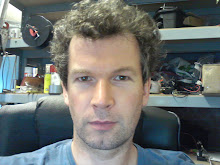
 I made another part from aluminium alloy.
I made another part from aluminium alloy.There were a few lessons learnt here. The most exciting one was where I hadn't tightened the 16mm tool holder into its collet enough. I noticed the tool was cutting deeper than it should, so I paused the machine and set the z lower so it would cut higher.
I started again but it continued to cut deeper as it went. I stopped and adjusted the z value again. I assumend that something was going wrong with the Z axis drive of my machine. I continued to cut until the tool holder fell out and wedged over at an angle!
Fortunately nothing had been damaged, as far as I can tell, and the part had been cut oversize, where it went wrong, so it should be OK.
I had to stop there, yesterday. I came back this morning and tried again. I looked at various positions of the part on the computer and then set the x, y, z of the machine by touching the tool against already machined faces of the part, with a piece of paper. However, as soon as the tool started cutting metal again, the part came unglued. The coolant had unstuck the super-glue, overnight.
I pressed the big red button, took the part off, cleaned it up, machined a new area in the wood, with some islands to locate the part. It was a bit of a tight fit, so I hammered the part down to glue it down. This probably isn't good for my machine, although it is resting on a lump of wood.
I am happy with the finished part. I did have to hammer it straight again afterwards though.
Another thing, I have seen before, is where I am cutting a sharp inside corner ( or one the same radius as the tool radius ). On the finish pass, the amount of material taken off is quite accurate because there is not much deflection or vibration until it gets to the sharp corner. It then momentarily squeals as it cuts the entire corner in one instant. You can see from the last picture how there is a lot of deflection ( I gues about 0.3mm on my 6mm tool. A solution would be to change the shape of the pocket so that the internal radiuses are at least a bit more than the tool radius, or to use a smaller tool.














